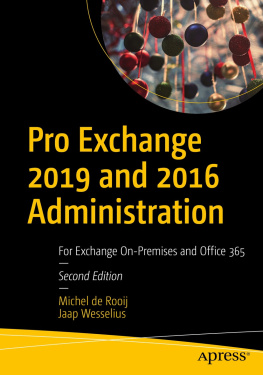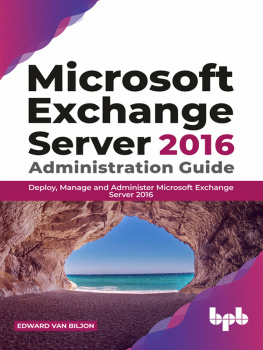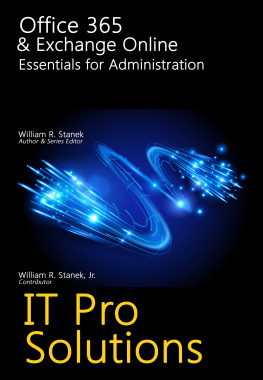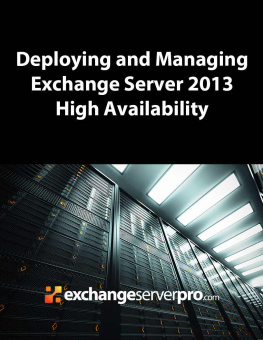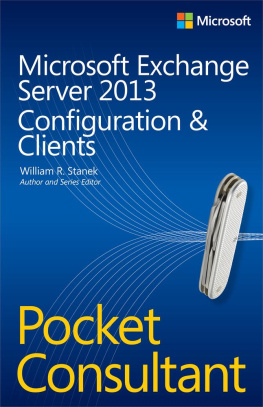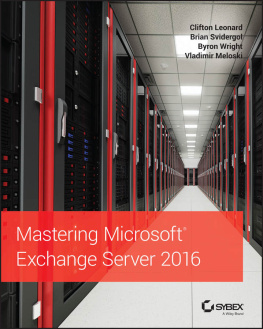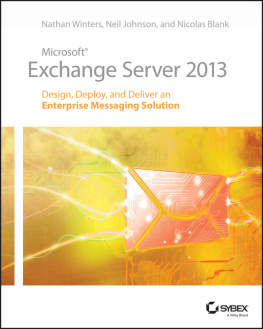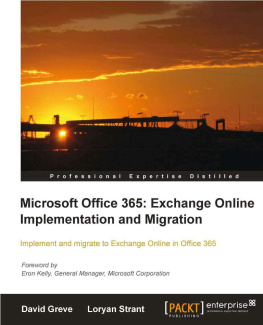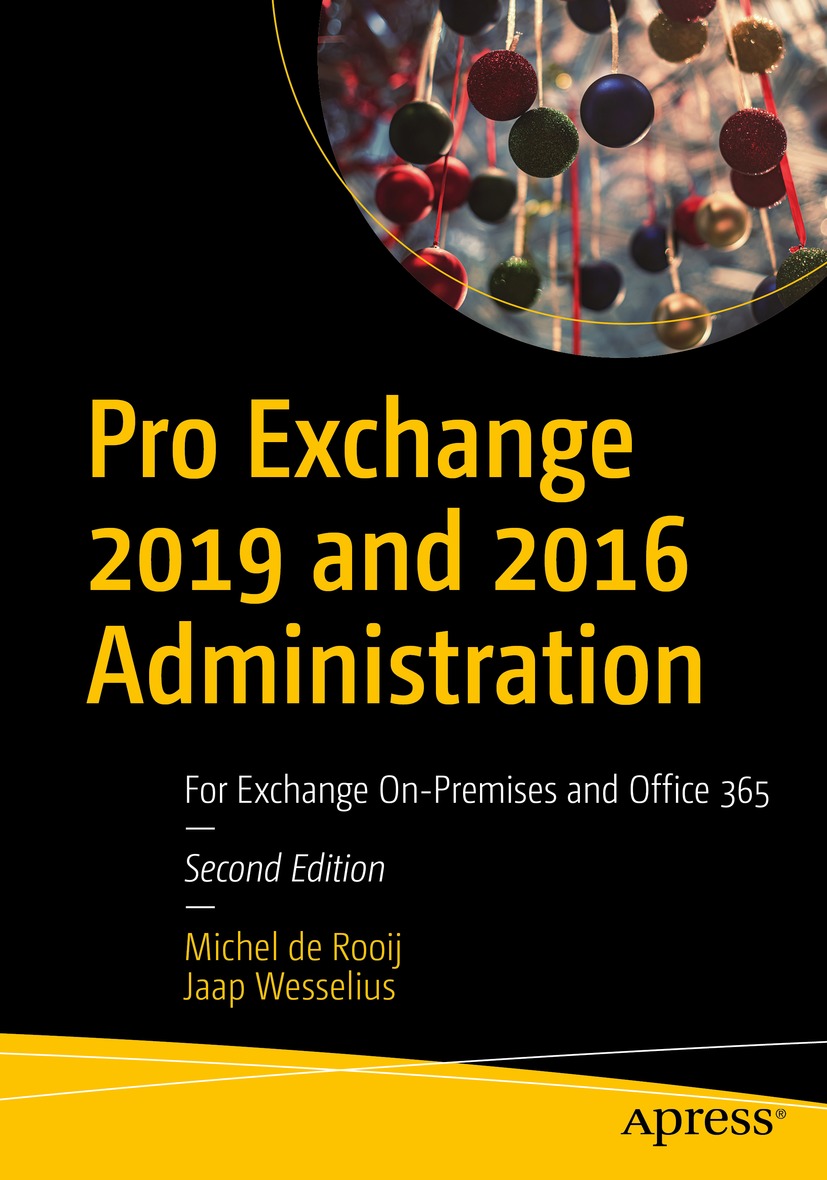Michel de Rooij and Jaap Wesselius
Pro Exchange 2019 and 2016 Administration
For Exchange On-Premises and Office 365
2nd ed.

Logo of the publisher
Michel de Rooij
VLEUTEN, Utrecht, The Netherlands
Jaap Wesselius
MARKNESSE, Flevoland, The Netherlands
ISBN 978-1-4842-7330-2 e-ISBN 978-1-4842-7331-9
https://doi.org/10.1007/978-1-4842-7331-9
Michel de Rooij and Jaap Wesselius 2022
This work is subject to copyright. All rights are solely and exclusively licensed by the Publisher, whether the whole or part of the material is concerned, specifically the rights of translation, reprinting, reuse of illustrations, recitation, broadcasting, reproduction on microfilms or in any other physical way, and transmission or information storage and retrieval, electronic adaptation, computer software, or by similar or dissimilar methodology now known or hereafter developed.
The use of general descriptive names, registered names, trademarks, service marks, etc. in this publication does not imply, even in the absence of a specific statement, that such names are exempt from the relevant protective laws and regulations and therefore free for general use.
The publisher, the authors and the editors are safe to assume that the advice and information in this book are believed to be true and accurate at the date of publication. Neither the publisher nor the authors or the editors give a warranty, expressed or implied, with respect to the material contained herein or for any errors or omissions that may have been made. The publisher remains neutral with regard to jurisdictional claims in published maps and institutional affiliations.
This Apress imprint is published by the registered company APress Media, LLC part of Springer Nature.
The registered company address is: 1 New York Plaza, New York, NY 10004, U.S.A.
Introduction
I have been working with Exchange since 1997 when Microsoft introduced Exchange server 5.0. Over the years, a lot has changed in Exchange, or as they say in marketing terms, it has been built from the ground up, and with the move writing Exchange in managed code (i.e., .NET), thats completely true.
But theres this other beast called Exchange Online, part of Office 365. It is not a big secret that Microsoft wants everybody to move to Office 365, and for a lot of customers, that is the best solution. All Microsoft developments and new features are in the cloud, and Exchange server on-premises is in a status quo. There are not a lot of new developments, and all updates are about stability and security.
But why a book about Exchange server? There still is a demand for Exchange server on-premises. Sometimes, organizations are running Exchange server for the wrong reason (the cloud is too expensive, for example), but there are organizations that do not want to be the first, or they cannot move to the cloud for legal reasons. Do not forget there are still millions of mailboxes on-premises, and this book is targeted for administrators that are completely moving to the cloud anytime soon and still have Exchange servers on-premises. This can be a full on-premises environment and I still have these types of customers, but also in a hybrid environment where Exchange server on-premises is configured with Exchange Online.
This book is divided into four parts:
Exchange InfrastructureIn this part, we cover an introduction and how to install and configure Exchange server. We will also cover the Client Access and the mailbox services, which were dedicated server roles in previous Exchange versions. Managing Mailboxes and mail transport are also included in this part.
Upgrading Exchange ServerIn this part, we discuss the upgrade path from Exchange 2010 to Exchange 2016 and from Exchange 2013 to Exchange 2019. Why an Exchange 2010 upgrade path? In our experience, a lot of customers are still running Exchange 2010, and they must move to Exchange 2016 anytime soon since Exchange 2010 is not supported at all anymore. From a security perspective, this is an unacceptable situation.
Integration with Office 365Although this is a book about Exchange server on-premises, customers are running an Exchange hybrid environment, and we should not close our eyes to this. And running Exchange hybrid can be the best of both worlds. This part covers identities, directory synchronization, Exchange federations, Autodiscover in a hybrid environment, and Exchange Online Protection.
Security and ComplianceThis is perhaps one of the most important aspects of running any environment. In this part, we cover authentication methods, including Hybrid Modern Authentication, Multi-Factor Authentication, and Role-Based Access Control (RBAC). Chapter focuses more on safeguarding the information with features like journaling, in-place hold and eDiscovery, messaging records management, data loss prevention, and auditing.
There still is demand for Exchange server on-premises, and there still is demand for an up-to-date book about Exchange server on-premises. This book is about Exchange 2019 and also covers Exchange 2016 and Exchange 2013 where appropriate. Exchange server is not dead, since Microsoft already announced a new version of Exchange on-premises, at the time of writing, referred to as Exchange vNext. From the information publicly available, I do not expect too much changes in Exchange vNext.
But until then, enjoy Exchange 2019 and never stop learning.
Acknowledgments
Another book! When Jaap asked me if I wanted to join him in writing the successor to our previous book that we both co-authored in 2014, I immediately got enthusiastic again. And now, after a few months, the fruit of our labor has once more seen the light. It always is an interesting and rewarding experience. The amount of depth and widening is intense, especially in the cloud era where the rate of change is insane. Then, when you finish writing, you feel you achieved something. Something useful for people that are on their own learning path, be it Exchange or Microsoft 365, something to help them understand and grow.
Again, a word of thanks to Jaap Wesselius for getting me on board this project. Finally, I am grateful to my wife Juliana, two kids, and family who had to share me in the evenings with this project as well. This, while already working from home during the pandemic. Also to the community, and especially the MVPs, intelligent people that are never hesitant to help out or exchange ideas. To you and everybody else I forgot, I say thank you.
Michel
Table of Contents
Part 1: Exchange Infrastructure
Part 2: Upgrading Exchange Server
Part 3: Integration with Office 365
Part 4: Security and Compliance
About the Authors
Michel de Rooij
is a consultant and Microsoft MVP since 2013. He lives in the Netherlands and has been working in the IT industry for over 20 years. Michel helps customers with their journeys related to Microsoft 365, with a focus on Exchange and Identity, but also related technologies such as Microsoft Teams or email in general. Michel has a developer background, but after some long-term dedicated Exchange-related work for a large multinational, he switched to Exchange and never looked back. He is also a big fan of automating processes and procedures related to infrastructure, being either supporting projects or automating administrator tasks. Michel is also active in online communities, such as the Microsoft Tech Community, and on social media such as Twitter (@mderooij). He runs an Exchange-related blog at eightwone.com, guest authors for several other sites, and speaks at international events.

